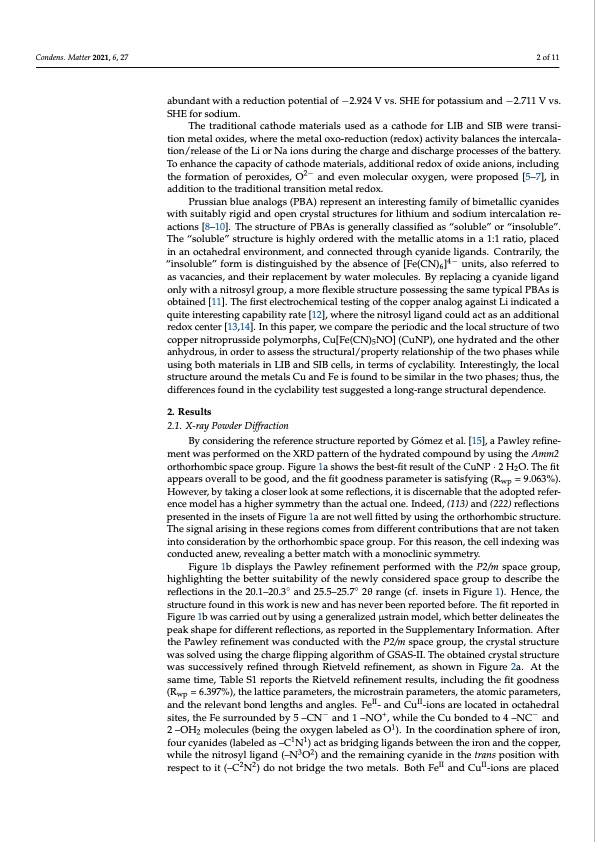
PDF Publication Title:
Text from PDF Page: 002
Condens. Matter 2021, 6, 27 2 of 11 abundant with a reduction potential of −2.924 V vs. SHE for potassium and −2.711 V vs. SHE for sodium. The traditional cathode materials used as a cathode for LIB and SIB were transi- tion metal oxides, where the metal oxo-reduction (redox) activity balances the intercala- tion/release of the Li or Na ions during the charge and discharge processes of the battery. To enhance the capacity of cathode materials, additional redox of oxide anions, including the formation of peroxides, O2− and even molecular oxygen, were proposed [5–7], in addition to the traditional transition metal redox. Prussian blue analogs (PBA) represent an interesting family of bimetallic cyanides with suitably rigid and open crystal structures for lithium and sodium intercalation re- actions [8–10]. The structure of PBAs is generally classified as “soluble” or “insoluble”. The “soluble” structure is highly ordered with the metallic atoms in a 1:1 ratio, placed in an octahedral environment, and connected through cyanide ligands. Contrarily, the “insoluble” form is distinguished by the absence of [Fe(CN)6]4− units, also referred to as vacancies, and their replacement by water molecules. By replacing a cyanide ligand only with a nitrosyl group, a more flexible structure possessing the same typical PBAs is obtained [11]. The first electrochemical testing of the copper analog against Li indicated a quite interesting capability rate [12], where the nitrosyl ligand could act as an additional redox center [13,14]. In this paper, we compare the periodic and the local structure of two copper nitroprusside polymorphs, Cu[Fe(CN)5NO] (CuNP), one hydrated and the other anhydrous, in order to assess the structural/property relationship of the two phases while using both materials in LIB and SIB cells, in terms of cyclability. Interestingly, the local structure around the metals Cu and Fe is found to be similar in the two phases; thus, the differences found in the cyclability test suggested a long-range structural dependence. 2. Results 2.1. X-ray Powder Diffraction By considering the reference structure reported by Gómez et al. [15], a Pawley refine- ment was performed on the XRD pattern of the hydrated compound by using the Amm2 orthorhombic space group. Figure 1a shows the best-fit result of the CuNP · 2 H2O. The fit appears overall to be good, and the fit goodness parameter is satisfying (Rwp = 9.063%). However, by taking a closer look at some reflections, it is discernable that the adopted refer- ence model has a higher symmetry than the actual one. Indeed, (113) and (222) reflections presented in the insets of Figure 1a are not well fitted by using the orthorhombic structure. The signal arising in these regions comes from different contributions that are not taken into consideration by the orthorhombic space group. For this reason, the cell indexing was conducted anew, revealing a better match with a monoclinic symmetry. Figure 1b displays the Pawley refinement performed with the P2/m space group, highlighting the better suitability of the newly considered space group to describe the reflections in the 20.1–20.3◦ and 25.5–25.7◦ 2θ range (cf. insets in Figure 1). Hence, the structure found in this work is new and has never been reported before. The fit reported in Figure 1b was carried out by using a generalized μstrain model, which better delineates the peak shape for different reflections, as reported in the Supplementary Information. After the Pawley refinement was conducted with the P2/m space group, the crystal structure was solved using the charge flipping algorithm of GSAS-II. The obtained crystal structure was successively refined through Rietveld refinement, as shown in Figure 2a. At the same time, Table S1 reports the Rietveld refinement results, including the fit goodness (Rwp = 6.397%), the lattice parameters, the microstrain parameters, the atomic parameters, and the relevant bond lengths and angles. FeII- and CuII-ions are located in octahedral sites, the Fe surrounded by 5 –CN− and 1 –NO+, while the Cu bonded to 4 –NC− and 2 –OH2 molecules (being the oxygen labeled as O1). In the coordination sphere of iron, four cyanides (labeled as –C1N1) act as bridging ligands between the iron and the copper, while the nitrosyl ligand (–N3O2) and the remaining cyanide in the trans position with respect to it (–C2N2) do not bridge the two metals. Both FeII and CuII-ions are placedPDF Image | Cross-Investigation on Copper Nitroprusside: Combining XRD and XAS

PDF Search Title:
Cross-Investigation on Copper Nitroprusside: Combining XRD and XASOriginal File Name Searched:
condensedmatter-06-00027-v2.pdfDIY PDF Search: Google It | Yahoo | Bing
Sulfur Deposition on Carbon Nanofibers using Supercritical CO2 Sulfur Deposition on Carbon Nanofibers using Supercritical CO2. Gamma sulfur also known as mother of pearl sulfur and nacreous sulfur... More Info
CO2 Organic Rankine Cycle Experimenter Platform The supercritical CO2 phase change system is both a heat pump and organic rankine cycle which can be used for those purposes and as a supercritical extractor for advanced subcritical and supercritical extraction technology. Uses include producing nanoparticles, precious metal CO2 extraction, lithium battery recycling, and other applications... More Info
| CONTACT TEL: 608-238-6001 Email: greg@infinityturbine.com | RSS | AMP |